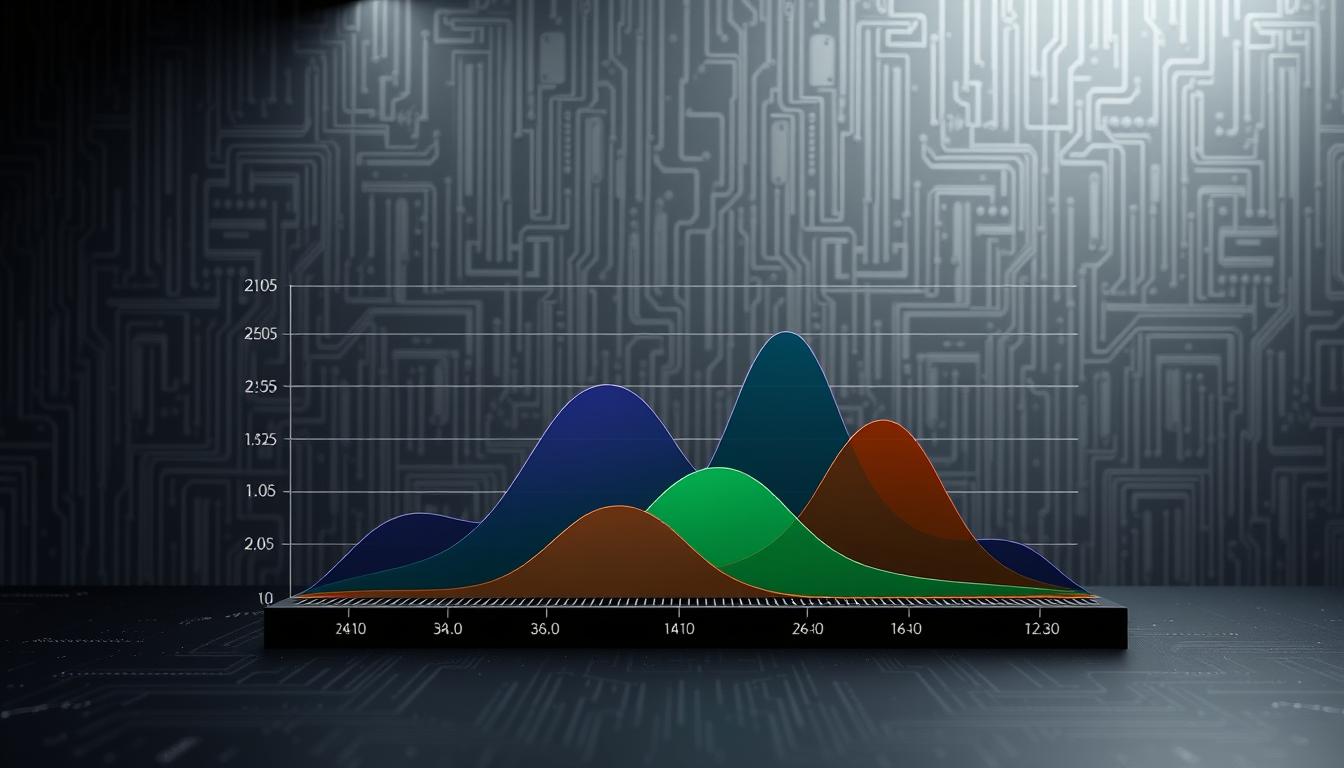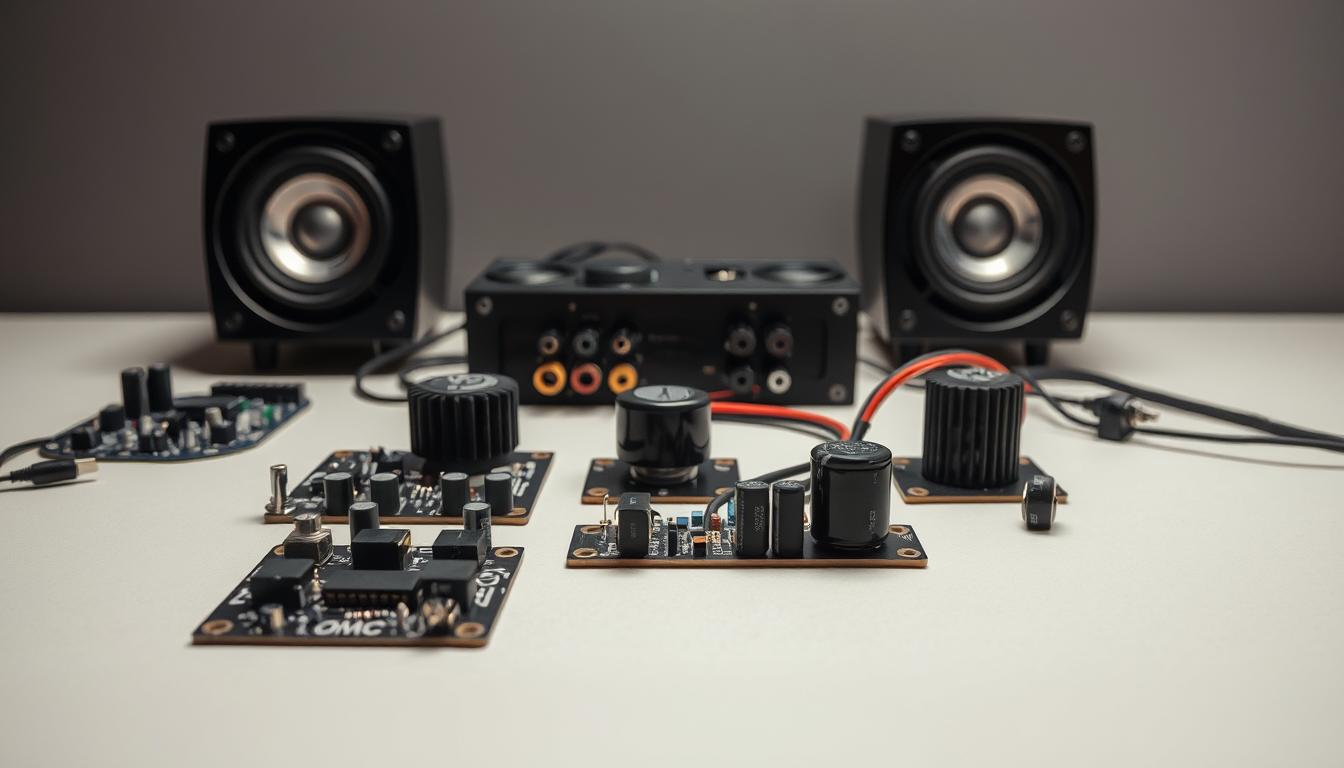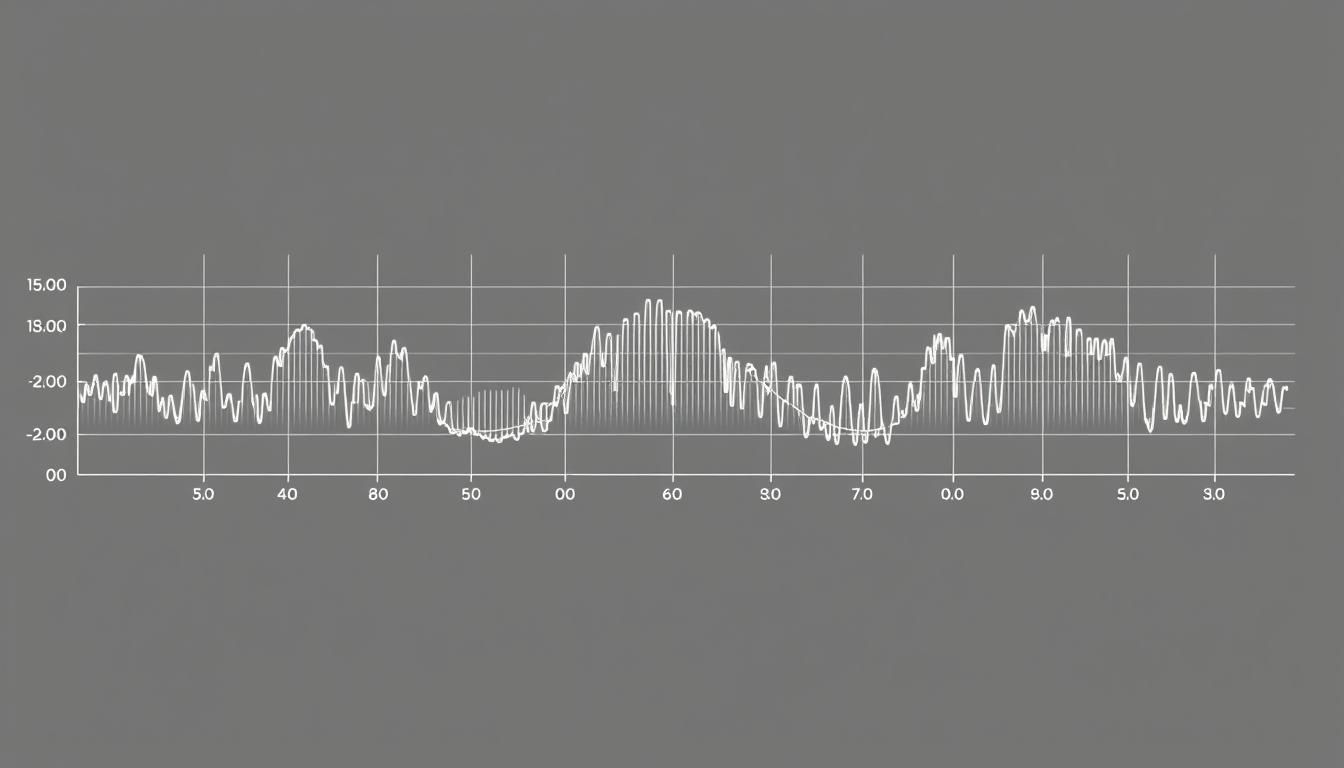Did you know that over 65% of audio enthusiasts report distorted sound in their systems due to improper crossover configurations? This critical setting, often overlooked, determines whether your speakers deliver crisp vocals, punchy bass, or harsh noise. Crossover frequencies act as invisible traffic directors, ensuring each sound element reaches the right driver at the perfect moment.
Every audio system relies on precise frequency division to prevent overlapping ranges that cause muddiness or damage. When set correctly, these transition points let woofers handle deep lows while tweeters manage sparkling highs – creating a unified soundstage. The process involves strategic filtering through your AV receiver, redirecting frequencies to speakers best equipped to reproduce them.
Proper crossover management isn’t just for audiophiles. Whether optimizing a home theater setup or car audio system, these settings protect your hardware while enhancing clarity. They eliminate abrupt shifts between drivers, letting instruments and vocals flow naturally across your listening space.
Key Takeaways
- Crossover frequencies prevent speaker overload by directing specific ranges to appropriate drivers
- Accurate settings eliminate distortion and create balanced audio across all frequencies
- AV receivers use digital processing to filter and redirect sound signals
- Proper configuration protects equipment while maximizing performance
- Smooth transitions between drivers mimic professional studio quality
- Settings vary between home theaters, car systems, and studio monitors
Introduction to Crossover Frequencies in Audio Systems
Human ears detect vibrations spanning 20 Hz rumbles to 20,000 Hz whistles – a spectrum requiring specialized speakers. Crossover frequencies split this range like precision filters, directing bass to woofers and treble to tweeters. Without these dividers, your audio system would struggle with muddy mids or piercing highs.

What Are Crossover Frequencies?
Think of crossovers as audio traffic controllers. They use electronic filters to block unwanted frequencies from reaching incompatible drivers. A 3-way speaker system might route:
- 20-80 Hz to subwoofers
- 80 Hz-2.5 kHz to midrange drivers
- 2.5 kHz-20 kHz to tweeters
This division prevents distortion caused by overlapping ranges. Woofers won’t strain to reproduce cymbals, while tweeters avoid bass overload.
Why Seamless Transitions Matter
Abrupt frequency handoffs create sonic potholes. A poorly tuned crossover might leave vocals sounding hollow or drums lacking punch. Phase alignment ensures drivers work in harmony, not competition.
“Great crossovers disappear – you hear music, not separate speakers.”
Proper transitions eliminate gaps where instruments vanish and overlaps causing ear fatigue. Your brain perceives a unified soundstage, whether hearing a cello’s growl or a flute’s shimmer.
Understanding the Role of Crossovers in Speaker Systems
Modern audio systems rely on crossovers like orchestras need conductors. These hidden components manage how sound gets distributed between specialized drivers. Without them, your music would resemble a chaotic jam session rather than a polished performance.

Speaker Drivers and Frequency Ranges
Every driver has its specialty. Woofers handle earth-shaking bass, midrange drivers carry vocals, and tweeters deliver crisp highs. Crossovers act as audio bouncers, ensuring each component only works within its ideal frequency zone.
Two-way systems split duties between woofers and tweeters. The crossover typically kicks in around 3,000 Hz. Three-way designs add midrange drivers, creating two transition points:
| System Type | First Crossover | Second Crossover | Components |
|---|---|---|---|
| 2-Way | 3,000 Hz | N/A | Woofer + Tweeter |
| 3-Way | 500 Hz | 3,500 Hz | Woofer + Mid + Tweeter |
Passive crossovers built into speakers use capacitors and coils to filter signals. Active versions process audio before amplification, offering precise control. Both types prevent tweeters from receiving bass signals that could shred their delicate diaphragms.
“Proper crossover design turns separate drivers into a unified instrument.” – Audio Engineering Journal
Component speakers separate these networks for fine-tuning, while coaxial models bake them into the design. Your choice depends on whether you prioritize customization or simplicity.
How to Set Crossover Frequencies for Seamless Transitions
Audio engineers compare crossover networks to precision gatekeepers. These electronic circuits use resistors, capacitors, and inductors to split audio signals into distinct bands. The magic happens at the -3dB point, where filters begin reducing unwanted frequencies by half their power.

Fundamental Concepts and Terminology
Three filter types govern sound distribution. Low pass variants let bass notes flow to subwoofers while blocking highs. High pass models do the opposite, shielding tweeters from damaging lows. Band pass designs create narrow windows for midrange drivers.
| Filter Type | Frequency Range | Component Use | Slope Impact |
|---|---|---|---|
| Low Pass | Below cutoff | Subwoofers | Gentle roll-off |
| High Pass | Above cutoff | Tweeters | Steep attenuation |
| Band Pass | Midrange only | Mid drivers | Dual slopes |
“Crossover slopes decide whether transitions sound like waterfalls or brick walls.”
Slopes determine how sharply frequencies drop beyond cutoff points. A 6dB/octave slope acts like a gradual hill, while 24dB/octave works like a cliff. Steeper slopes prevent driver overlap but require precise phase alignment.
Balancing cutoff frequencies with slope steepness prevents gaps or clashes in your soundstage. Test different combinations to match your speakers’ capabilities and room acoustics. Proper tuning makes drivers vanish, leaving pure musical immersion.
Manual Setup and Calibration Techniques
Manual calibration transforms your audio system from functional to exceptional. This hands-on approach lets you tailor sound reproduction to your space and equipment, particularly crucial in car audio environments where cabin acoustics vary wildly.
Conducting Listening Tests and Determining Frequency Ranges
Start with reference tracks you know intimately. Play bass-heavy passages through your drivers while gradually increasing volume. Note when vibrations turn muddy – that’s your distortion threshold. Most woofers reveal their clean range between 30-80 Hz in car setups.

Adjusting Gain and Level Controls for Balance
Set amplifier control knobs to minimum before activation. Engage high-pass filters first, then low-pass. Use this sequence:
- Increase gain until distortion appears
- Reduce by 10% for headroom
- Test midrange drivers at 80-2500 Hz
Car audio systems demand extra attention to power limitations. A proper level match prevents front speakers from overpowering rear ones.
“Calibration isn’t about perfection – it’s about creating cohesion between components.”
Final tests should make frequency transitions undetectable. If you hear gaps between bass and mids, adjust crossover points in 5 Hz increments. Your experience improves dramatically when drivers operate as a unified system rather than isolated elements.
Advanced Concepts: Filters, Slopes, and Alignment
Your audio system’s crossover design determines whether you hear precision or chaos. Two approaches dominate modern setups: passive and active configurations. Each method shapes sound differently through component choices and signal processing.
Passive Crossovers: Simple but Limited
Passive crossovers sit between amplifiers and speakers. They use capacitors, inductors, and resistors to filter amplified signals. These components block unwanted frequencies but waste power through resistance.
Most factory speakers include built-in passive networks. While easy to install, cheaper models often struggle with uneven frequency response. Component quality directly impacts performance – budget inductors may distort bass notes.
Active Crossovers: Precision Engineering
Active crossovers process signals before amplification. They require separate power supplies but eliminate energy waste. This setup lets amplifiers focus full power on specific frequency ranges.
You gain control over:
- Exact crossover points
- Slope steepness
- Phase alignment
| Feature | Passive | Active |
|---|---|---|
| Signal Type | Speaker Level | Line Level |
| Components | Capacitors/Inductors | Electronic Circuits |
| Efficiency | 75-85% | 95-98% |
| Customization | Limited | Full Control |
Filter slopes dictate how quickly frequencies drop beyond cutoff points. A 6dB/octave slope blends drivers smoothly, while 24dB/octave creates sharp divisions. Most systems use 12dB slopes for balanced performance.
“Steeper slopes protect drivers better but demand perfect phase alignment.” – Audio Design Handbook
Choose slopes based on your speakers’ capabilities and room acoustics. Proper alignment ensures seamless transitions between frequency ranges without timing issues.
Real-World Applications and Troubleshooting
Car audio enthusiasts often face unique challenges when tuning crossover systems. Road noise competes with music, while limited cabin space creates acoustic hotspots. Proper configuration prevents speakers from fighting these conditions.
Troubleshooting Common Crossover Issues
Distorted vocals? Check for frequency overlaps between midrange drivers and tweeters. If bass sounds thin, verify your subwoofer’s low-pass filter isn’t set too high. Always test impedance matches – a 4-ohm driver paired with an 8-ohm crossover cuts power output by half.
Phase cancellation often manifests as “missing” frequencies. Reverse tweeter polarity if vocals sound hollow. For car systems, ensure door speakers and dash tweeters share matching crossover points – 3,500 Hz works for most 2-way setups.
Tips for Optimizing Car Audio Systems
Start with 80 Hz for subwoofers and 60 Hz high-pass filters on door speakers. This prevents bass distortion while protecting smaller drivers. Use time alignment tools to sync audio arrival times – critical in asymmetrical vehicle cabins.
Upgrade factory systems gradually. Add component speakers with external crossovers before installing amplifiers. Avoid mixing coaxial and component designs, as their built-in filters create conflicting frequency ranges.
Remember: There’s no universal setting. Test different crossover points while playing music you know well. Your ears will reveal what measurements can’t – the sweet spot where technology meets musicality.
FAQ
What happens if crossover frequencies aren’t set correctly?
Incorrect crossover settings cause distorted sound, uneven frequency response, or phase issues. Drivers may reproduce frequencies outside their optimal range, leading to muddied bass, harsh highs, or weak midrange transitions. Proper calibration ensures each speaker operates within its design limits.
How do passive crossovers differ from active crossovers?
Passive crossovers use inductors and capacitors to split signals after amplification, requiring no external power. Active crossovers process signals before amplification, offering precise control over slopes and frequencies but needing dedicated power and wiring. Brands like MiniDSP or Rockford Fosgate specialize in active systems for advanced customization.
Can I adjust crossover slopes for better transitions?
Yes. Steeper slopes (24dB/octave) isolate frequencies sharply, reducing overlap between drivers. Gentle slopes (6dB/octave) allow smoother blending but risk distortion. Match slope types—Butterworth, Linkwitz-Riley—to your system’s needs. For example, car audio setups often use 12dB/octave slopes for balanced transitions.
Why do tweeters and woofers require different crossover points?
Tweeters handle high frequencies (2kHz–20kHz), while woofers manage lows (20Hz–2kHz). Overlapping ranges create phase cancellation or driver damage. Set crossover points based on driver specs—like a 3kHz high-pass for tweeters and 80Hz low-pass for subwoofers—to maintain clarity and protect components.
How do I test crossover settings without professional tools?
Use frequency sweep tracks or pink noise to identify gaps or peaks. Adjust crossover points incrementally while listening for smooth transitions. Brands like Dayton Audio offer affordable measurement mics for room correction. Trust your ears—uneven vocals or boomy bass signal misaligned crossovers.
What role do capacitors play in passive crossovers?
Capacitors block low frequencies from reaching tweeters, acting as high-pass filters. Combined with inductors (low-pass filters for woofers), they direct specific ranges to each driver. Quality capacitors, like Mundorf or Jantzen, minimize signal loss and phase shift for accurate sound reproduction.
Can mismatched impedance damage crossover components?
Yes. Impedance mismatches strain crossover networks, causing overheating or failure. Ensure drivers match the crossover’s rated impedance (e.g., 4Ω or 8Ω). Brands like JL Audio design crossovers with protection circuits to handle impedance fluctuations in car audio systems.
How do room acoustics affect crossover performance?
Reflections and standing waves alter perceived frequency response. For home theaters, use calibration tools like Audyssey to adapt crossovers to room dimensions. In cars, sound deadening materials from Dynamat reduce vibrations, ensuring cleaner transitions between midbass and tweeters.
Are bi-ampable speakers better for crossover tuning?
Bi-amping separates frequency bands before amplification, bypassing passive crossovers. This reduces intermodulation distortion and allows precise active tuning. Brands like Klipsch offer bi-ampable speakers for enthusiasts seeking granular control over midrange and treble balance.
What’s the ideal crossover point for a subwoofer in a car audio system?
Start with an 80Hz low-pass filter to blend with midbass drivers. Adjust based on cabin gain—smaller cars may need 60Hz to avoid boomy resonance. Pair with a high-pass filter (100Hz) for door speakers using a head unit or DSP like the Alpine PXE-X09.


